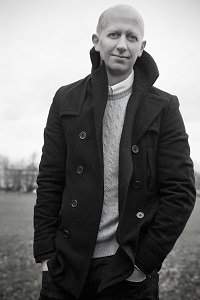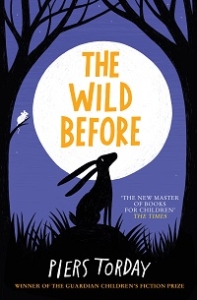
The Wild Before: An Interview with Piers Torday
Michelle Pauli talks prequels, honesty and hope with Piers Torday.
‘No one should ever do a prequel,’ says Piers Torday, laughing, as we meet on Zoom to talk about his – yes – prequel. ‘I’ve broken a cardinal rule…’
If he has, it’s worth it. The Wild Before is a powerful exploration of the damage wrought to the natural environment and the possibility that hope and friendship can create a new story for the world. It takes place before the events in his acclaimed trilogy, which began with The Last Wild, followed by the Guardian children’s fiction prize-winning The Dark Wild and concluded in 2015 with The Wild Beyond. All three are set in a world ruined by climate change with almost all animals wiped out by the ‘red-eye’ plague. The Wild Before explains how Little-Hare seeks to save the magical Mooncalf and find the flower of hope as the plague sets in and the ‘Terribleness’ of drought, floods and fires begins.
But what made Torday revisit his Wild world after six years? ‘I heard what Greta Thunberg was saying,’ he says. ‘I heard her message and it was that the world is on fire.’ Inspired, and aware that the climate crisis had become an emergency in the time since he had written his trilogy, and is increasingly challenging for young people, he also realised that he had a ready-made world in which to explore it: ‘It seemed silly to invent a whole new set of characters when I’d created these to talk about this issue.’
And, for Torday, these creations are critical in treading the fine line between being realistic about a dire situation and utter bleak despair. After all, the human-caused destruction of our planet is clearly not an easy topic to cover in a children’s book.
Using animal characters is a familiar ploy to introduce just enough distance to reduce the possibility of trauma. ‘Children aren’t experiencing some of the very frightening things: it’s animals. While most children care deeply about animals and even sometimes identify with them, it’s at a remove – it’s not only in a book, it’s happening to an animal in a story. I hope what you get is emotional engagement but at a safe distance and with human warmth,’ he explains.
So we see familiar characters such as Stag, Harvest Mouse and others in the time before the plague, along with some new creations (straight-talking Waxwing is a simply glorious representation of Thunberg in bird form).
The other crucial element is humour – ‘No situation is ever too bleak for a singing animal to lighten the mood!’ – but, above all, he believes in the value of honesty.
Torday is aware of how much his own imagination was shaped by the films and books he read as a child, from the Animals of Farthing Wood to Watership Down. As such he is also aware of the power fiction holds to inspire change – ‘it just takes one child to read any book to become a Greta Thunberg, and that’s a huge win for everyone. That’s the amazing magic of books’ – and he hopes that young readers of The Wild Before will feel like they can make a difference, however small their actions might seem.
‘Small change is vital because every time you make a small change and decide to eat less meat or no meat, or stop flying or reduce plastic consumption, or remember to turn lights off, or pick up some litter or recycle, those small things create a cultural backdrop where the bigger change becomes inevitable and harder to resist,’ he urges. ‘The bigger change, the structural change, is the really difficult knotty stuff that’s going to require huge political will – but that political will is going to come from people pressure and from the ground up.’
He’s also pushing for the publishing industry to get its own house in order – again by looking at small wins such as reducing plastic waste in packaging and at book launches, followed by constructive conversations about the more challenging issues around print runs and logistics.
While he says ‘never say never’ about another return to Wild he has no immediate plans to do so. His next book remains in the natural world, though, with trees at its centre. Inspired by Richard Powers’s Pulitzer-winning The Overstory, in which the trees are characters too, and Merlin Sheldrake’s recent groundbreaking work on the astonishingly connected world of fungi, Torday is interested in de-centering the human experience and ‘engaging children in these magnificent ancient organisms in a world that is ripe for fantasy exploration.’
Coming up even sooner is an exciting theatre adaptation of his 2016 novel There May Be a Castle by Little Angel Theatre at the end of the year. Those who have read the book may be relieved to know that the company ‘found a beautiful, elegant, creative, truthful way to honour the ending without sending people out into the street on a Christmas night, sobbing their hearts.’
The same can equally be said about The Wild Before, which is ultimately about hope and the possibility that it’s not too late.
As Torday puts it, ‘It’s as much of a love song to what we have now as opposed to the other books, which are very much a dystopia and this is what it might be if we lose everything. Despite the loss we’ve been inflicting over the last 70 years or so, our world is still very beautiful and still very precious and absolutely worth saving and fighting for.’
For Torday himself, the flower of hope lies in the very people he writes for.
‘When you look at this next generation and some of the sacrifices they’re willing to make, the principles, the stands they are taking on a whole range of issues – everything from trans rights to the environment – I find them very inspiring because they are our future. They’re taking it incredibly seriously and we’re very lucky to have them. It gives me hope,’ he says, simply.
Michelle Pauli is a freelance writer and editor specialising in books and education. She created and edited the Guardian children’s books site.
The Wild Before is published by Quercus, 978-1786541116, £12.99 hbk





